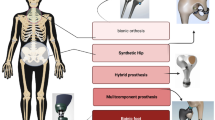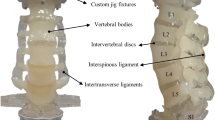Abstract
The objective of this research was to develop a purely biomechanical model, intended to predict the long-term secondary stability of the implant starting from the biomechanical stability immediately after the operation. A continuous rulebased adaptation scheme was formulated as a dynamic system, and the work verified if such a model produced unique and clinically meaningful solutions. It also investigated whether this continuous model provided results comparable with those of a simpler, discrete-states model used in a previous study. The proposed model showed stable convergence behaviour with all investigated initial conditions, with oscillatory behaviour limited to the first steps of the simulation. The results obtained with the wide range of initial conditions support the hypothesis of the existence and uniqueness of the solution for all initial conditions. The differences between the continuous model and the simpler and more efficient finite-states model were found to be extremely modest (less than 4% over the predicted bonded area). Because of these minimal differences, the use of the much faster finite-states model is recommended to investigate asymptotic conditions, and the continuous model described should be used to investigate the evolution over time of the adaptive process.
Similar content being viewed by others
References
Al-Saffar, N. (1999): ‘The osteogenic properties of the interface membrane at the site of orthopedic implants: the impact of underlying joint disease’,J. Long-Term Effects Med. Implants,9, pp. 23–45
Bernakiewicz, M., andViceconti, M. (2002): ‘The role of parameter identification in finite element contact analyses with reference to orthopaedic biomechanics applications’,J. Biomech.,35, pp. 61–67
Dalton, J. E., Cook, S. D., Thomas, K. A., andKay, J. F. (1995): ‘The effect of operative fit and hydroxyapatite coating on the mechanical and biological response to porous implants’,J. Bone Joint Surg. (Am). 77, pp. 97–110
Engh, C., O'Connor, D., Jasty, M., McGovern, T., Bobyn, J., andHarris, W. (1992): ‘Quantification of implant micromotion, strain shielding, and bone resorption with porous-coated anatomic medullary locking femoral prostheses’,Clin. Orthopaed. Related Res., pp. 13–29
Fessy, M. H., Seutin, B., andBejui, J. (1997): ‘Anatomical basis for the choice of the femoral implant in the total hip arthroplasty’,Surg. Radiol. Anatomy,19, pp. 283–286
Hofmann, S., Hopf, R., Mayr, G., Schlag, G., andSalzer, M. (1999): ‘In vivo femoral intramedullary pressure during uncemented hip arthroplasty’,Clin. Orthop. Related Res., pp. 136–146.
Jasty, M., Maloney, W. J., Bragdon, C. R., O'Connor, D. O., Haire, T., andHarris, W. H. (1991): ‘The initiation of, failure in cemented femoral components of hip arthroplasties’,J. Bone Joint Surg. (Br.),73, pp. 551–558.
Jasty, M., Bragdon, C. R., Zalenski, E., O'Connor, D., Page, A., andHarris, W. H. (1997): ‘Enhanced stability of uncemented canine femoral components by bone ingrowth into the porous coatings’,J. Arthroplasty,12, pp. 106–113
Kienapfel, H., Sprey, C., Wilke, A., andGriss, P. (1999): ‘Implant fixation by bone ingrowth’,J. Arthroplasty,14, pp. 355–368
LaPorte, D. M., Mont, M. A., andHungerford, D. S. (1999): ‘Proximally porous-coated ingrowth prostheses: limits of use’,Orthopedics,22, pp. 1154–1160, quiz pp. 1161–1162
Lintner, F., Zweymuller, K., andBrand, G. (1986): ‘Tissue reactions to titanium endoprostheses. Autopsy studies in four cases’,J. Arthroplasty,1, pp. 183–195
Maloney, W. J., Jasty, M., Burke, D. W., O'Connor, D. O., Zalenski, E. B., Bragdon, C., andHarris, W. H. (1989): ‘Biomechanical and histologic investigation of cemented total hip arthroplasties. A study of autopsy-retrieved femurs afterin vivo cycling’,Clin. Orthopaed. Related Res., pp. 129–140
Manley, P. A., Vanderby, R., Kohles, S., Markel, M. D., andHeiner, J. P. (1995): ‘Alterations in femoral strain, micromotion, cortical geometry, cortical porosity, and bony ingrowth in uncemented collared and collarless prostheses in the dog’,J. Arthroplasty,10, pp. 63–73
Monti, L., Cristofolini, L., andViceconti, M. (1999): ‘Methods for quantitative analysis of the primary stability in uncemented hip prostheses’,Artific. Organs,23, pp. 851–859
Nabae, M., Inoue, K., Ushiyama, T., andHukuda, S. (1999): ‘Gene expressions of antiinflammatory mediators in THR retrieved interfacial membranes’,Acta Orthopaed. Scand.,70, pp. 149–154
Ozeki, K., Yuhta, T., Aoki, H., Nishimura, I., andFukui, Y. (2001): ‘Push-out strength of hydroxyapatite coated by sputtering technique in bone’,Biomed. Materi. Eng.,11, pp. 63–68
Pilliar, R., Lee, J., andManiatopoulos, C. (1986): ‘Observations on the effect of movement on bone ingrowth into porous-surfaced implants’,Clin. Orthopaed. Related Res., pp. 108–113
Rancourt, D., Shirazi-Adl, A., Drouin, G., andPaiement, G. (1990): ‘Friction properties of the interface between porous-surfaced metals and tibial cancellous bone’,J. Biomed. Mater. Res.,24, pp. 1503–1519
Skripitz, R., andAspenberg, P. (1998): ‘Tensile bond between bone and titanium: a reappraisal of osseointegration’,Acta Orthopaed. Scand.,69, pp. 315–319
Soballe, K., Hansen, E. S., Brockstedt-Rasmussen, H., Pedersen, C. M., andBunger, C. (1990): ‘Hydroxyapatite coating enhances fixation of porous coated implants. A comparison in dogs between press fit and noninterference fit’,Acta Orthopaed. Scand.,61, pp. 299–306
Soballe, K., Hansen, E. S., Brockstedt-Rasmussen, H., Hjortdal, V. E., Juhl, G. I., Pedersen, C. M., Hvid, I., andBunger, C. (1991): ‘Gap healing enhanced by hydroxyapatite coating in dogs’,Clin. Orthopaed. Related Res., pp. 300–307
Soballe, K., Brockstedt-Rasmussen, H., Hansen, E. S., andBunger, C. (1992a): ‘Hydroxyapatite coating modifies implant membrane formation. Controlled micromotion studied in dogs’,Acta Orthopaed. Scand.,63, pp. 128–140
Soballe, K., Hansen, E. S., Rasmussen, H., Jorgensen, P. H., andBunger, C. (1992b): ‘Tissue ingrowth into titanium and hydroxyapatite-coated implants during stable and unstable mechanical conditions’,J Orthopaed. Res.,10, pp. 285–299
Soballe, K., Hansen, E. S., Brockstedt_Rasmussen, H., andBunger, C. (1993): ‘Hydroxyapatite coating converts fibrous tissue to bone around loaded implants’,J. Bone Joint Surg. (Br),75, pp. 270–278
Song, Y., Beaupre, G., andGoodman, S. B. (1999): ‘Osseointegration of total hip arthroplasties: studies in humans and animals’,J. Long-Term Effects Med. Implants,9, pp. 77–112
Spears, I. R., Pfleiderer, M., Schneider, E., Hille, E., Bergmann, G., andMorlock, M. M. (2000): ‘Interfacial conditions between a press-fit acetabular cup and bone during daily activities: implications for achieving bone in-growth’,J. Biomech.,33, pp. 1471–1477
Takei, I., Takagi, M., Santavirta, S., Ida, H., Ishii, M., Ogino, T., Ainola, M., andKonttinen, Y. T. (2000): ‘Messenger ribonucleic acid expression of 16 matrix metalloproteinases in bone-implant interface tissues of loose artificial hip joints’,J. Biomed. Mater. Res.,52, pp. 613–620
Toni, A., Fabbri, F., Scimeca, G. B., Zanotti Russo, M. C., Baruffaldi, F., Cianci, R., andGiunti, A. (1995): ‘Computerized morphometric analysis of the femoral diaphyseal canal’,La Chirurgia degli Organi di Movimento,80, pp. 207–219
Viceconti, M., Muccini, R., Bernakiewicz, M., Baleani, M., andCristofolini, L. (2000): ‘Large-sliding contact elements accurately predict levels of bone-implant micromotion relevant to osseointegration’,J. Biomech.,33, pp. 1611–1618
Viceconti, M., Monti, L., Muccini, R., Bernakiewicz, M., andToni, A. (2001): ‘Even a thin, layer of soft tissue may compromise the primary stability of cementless hip stems’,Clin. Biomech.,16, pp. 765–775
Viceconti, M., Pancanti, A., Dotti, M., Traina, F., andCristofolini, L. (2004): ‘Effect of the initial implant fitting on the predicted secondary stability of a cementless stem’,Med. Biol. Eng. Comput.,42, 2, pp. 222–229
Wagner, H., andWagner, M. (2000): ‘Cone prosthesis for the hip joint’,Arch. Orthopaed. Traum. Surg.,120, pp. 88–95
Wroblewski, B., andSiney, P. (1993): ‘Charnley low-friction arthroplasty of the hip. Long-term results’,Clin. Orthopaed. Related Res., pp. 191–201
Author information
Authors and Affiliations
Corresponding author
Rights and permissions
About this article
Cite this article
Viceconti, M., Ricci, S., Pancanti, A. et al. Numerical model to predict the longterm mechanical stability of cementless orthopaedic implants. Med. Biol. Eng. Comput. 42, 747–753 (2004). https://doi.org/10.1007/BF02345207
Received:
Accepted:
Issue Date:
DOI: https://doi.org/10.1007/BF02345207




